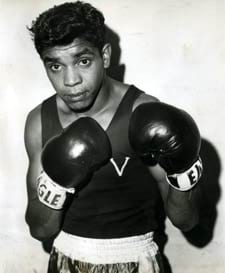
- Inducted:
- 2011
Lionel Rose was one of the greats of Australian sport and the lead character in a story that is the stuff of legend.
The oldest of seven boys and five girls, Lionel was born in 1948 in Warragul, not far from Jindivick, a small, impoverished Aboriginal settlement on Jackson's Track, where he grew up.
He learned the fundamentals of boxing from his father who, along with others from his extended family, competed in the tent boxing circuit that followed the local agricultural shows. Sadly his father - a Gunditjmara man - only saw him fight in a couple of local amateur bouts. After his father's death, Lionel worked several jobs, before staying to work as a welder at a company in Drouin. He remained there until he moved to Melbourne to turn professional.
It was a trainer named Frank Oakes who first recognised Lionel's potential. The two would train every night, wherever they could find a place. Eventually, Frank was offered the use of an empty hostel once occupied by staff of the railway refreshment room. He and Lionel established a permanent gym for training. Years later, in 1970, Lionel married Frank's daughter Jenny and the two embarked on a lifelong partnership. They have a son, Michael, and a granddaughter, Georgia.
In 1963, at age 15, Lionel won the national Australian Flyweight Title. The next year, he was narrowly beaten in the final of Olympic trials that would have seen him represent Australia at the Tokyo Olympics. He decided to become professional and his meteoric rise began.
Lionel and Frank searched for a suitable trainer in Melbourne. They settled on Jack Rennie, who welcomed Lionel to live with him, his wife Shirley and sons Mark and John.
From his first main event in Warragul to subsequent bouts at Melbourne's Festival Hall, Lionel was in top gear. He won the Australian Bantamweight Title from Noel Kunde in 1966 and defended it against Rocky Gatellari in Sydney in late 1967. This meant that he was an Australian champion at the time of the 1967 referendum. It came to be a symbolic representation of the few advances made in Indigenous rights around that time.
In February 1968 came a fight destined to enter the history books as one of the greatest moments in Australian sport.
Masahiko 'Fighting' Harada of Japan had already won the World Flyweight title, then the World Bantamweight Title, which he had successfully defended five times. To say that Lionel was the underdog going into their fight on February 27 1968 is an understatement, but 15 hard rounds later he emerged as Champion of the World. A 19 year old who had already won the affection and respect of the boxing world was catapulted into the stratosphere.
Lionel famously assumed the crowd awaiting his return home to Melbourne was assembled to welcome a pop group like the Beatles. 250,000 people lining the streets all the way into the city to welcome him home ensured that there was little doubt as to his new-found hero status.
He was named Australian of the Year in 1968 - the first Indigenous person to be given this honour - and was awarded an MBE. These were the first of numerous honours he would receive in his lifetime, which included an induction into the World Boxing Hall Of Fame, WBC Hall of Fame, a Deadly Award for a Lifetime Achievement in Sport, a specially created postage stamp of his gloves, a TV mini series based on his life, a documentary and a statue erected in his honour in his home town of Warragul. He was lucky enough to be invited onto a closed set in Hollywood to meet Elvis Presley. This remained one of his most treasured memories.
Lionel defended his world title four times over the next 18 months, finally losing it to Ruben Olivares in August 1969. He continued to box in a higher weight division, fighting his way through the ranks until he was world rated in the junior lightweight division. In June 1971, after narrowly losing on points in a World Junior Lightweight title fight in Japan, he retired. A brief comeback was attempted in 1975, but an ongoing struggle to remain dedicated to training meant Lionel retired for good in 1976.
Lionel also turned his talents to his great love – music – and released a single called 'I Thank You' in 1969. It reached number one in the charts and earned him two gold records. Lionel recorded two albums.
Despite his high profile, Lionel chose to work quietly behind the scenes. He involved himself in grassroots community work, mainly in the areas of reconciliation and Indigenous health. He was Patron of the Victorian Aboriginal Health Service from its very beginnings.
Although he had his fair share of personal setbacks later in life, it is for his achievements in the ring, along with his good nature, positive outlook and generosity that he remains best remembered. In testament to the enduring affection Australians felt for Lionel, a state funeral was held upon his death in May 2011. He not only gave this country one of its most inspiring modern stories of triumph against the odds, he deservedly earned himself the title of 'Australian Hero'.
Updated

